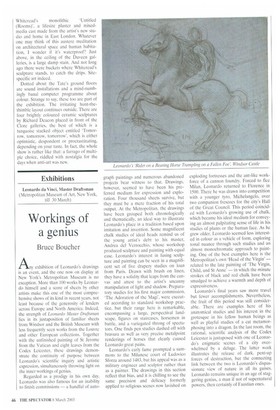Workings of a genius
Bruce Boucher
Aly exhibition of Leonardo's drawings is an event, and the one now on display at New York's Metropolitan Museum is no exception. More than 100 works by Leonardo himself and a score of sheets by other artists make this one of the most comprehensive shows of its kind in recent years, not least because of the generosity of lenders across Europe and North America. Indeed. the strength of Leonardo Master Draftsman lies in its juxtaposition of familiar sheets from Windsor and the British Museum with less frequently seen works from the Louvre and other European collections. Together with the unfinished painting of St Jerome from the Vatican and eight leaves from the Codex Leicester, these drawings demonstrate the continuity of purpose between Leonardo's scientific inquiry and artistic expression, simultaneously throwing light on the inner workings of genius.
Regarded as a prodigy in his own day, Leonardo was also famous for an inability to finish commissions — a handful of auto
graph paintings and numerous abandoned projects bear witness to that. Drawings, however, seemed to have been his preferred medium for expression and exploration. Four thousand sheets survive, but they must be a mere fraction of his total output. At the Metropolitan, the drawings have been grouped both chronologically and thematically, an ideal way to illustrate Leonardo's place in a tradition based upon imitation and invention. Some magnificent chalk studies of ideal heads remind us of the young artist's debt to his master, Andrea del Verrocchio, whose workshop produced sculpture and painting with equal ease. Leonardo's interest in fusing sculpture and painting can be seen in a magnificent set of five drapery studies on loan from Paris. Drawn with brush on linen, they have a solidity that leaps from the canvas and attest to the artist's uncanny manipulation of light and shadow. Preparatory studies for his first major commission, 'The Adoration of the Magi', were executed according to standard workshop practice, but their range here is remarkable, encompassing a large, perspectival landscape, figures on staircases, horsemen in battle, and a variegated throng of spectators. One finds pen studies dashed off with bravura as well as very precise metalpoint renderings of horses that clearly caused Leonardo great pains.
Leonardo's early fame prompted a summons to the Milanese court of Ludovico Sforza around 1483, but his appeal was as a military engineer and sculptor rather than as a painter. The drawings in this section reflect that bias, and it is chilling to see the same precision and delicacy formerly applied to religious scenes now lavished on exploding fortresses and the ant-like workforce of a cannon foundry. Forced to flee Milan, Leonardo returned to Florence in 1500. There he was drawn into competition with a younger tyro, Michelangelo, over two companion frescoes for the city's Hall of the Great Council. This period coincided with Leonardo's growing use of chalk, which became his ideal medium for conveying an almost palpitating sense of life in his studies of plants or the human face. As he grew older, Leonardo seemed less interested in colour as a vehicle of form, exploring tonal nuance through such studies and an almost monochromatic approach to painting. One of the best examples here is the Metropolitan's own 'Head of the Virgin' — related to the late painting of 'The Virgin, Child, and St Anne' — in which the minute strokes of black and red chalk have been smudged to achieve a warmth and depth of expressiveness.
Leonardo's final years saw more travel but fewer accomplishments. Nevertheless, the fruit of this period was still considerable. There arc examples here of his anatomical studies and his interest in the grotesque in his fellow human beings as well as playful studies of a cat metamorphosing into a dragon. In the last room, the rational, scientific analysis of the Codex Leicester is juxtaposed with one of Leonardo's enigmatic scenes of a city overwhelmed by a deluge. The latter work illustrates the release of dark, pent-up forces of destruction, but the connecting link between the two is Leonardo's dispassionate view of nature in all its guises. Leonardo remains unique in an age of staggering genius, a man if not of supernatural powers, then certainly of Faustian ones.


































































 Previous page
Previous page